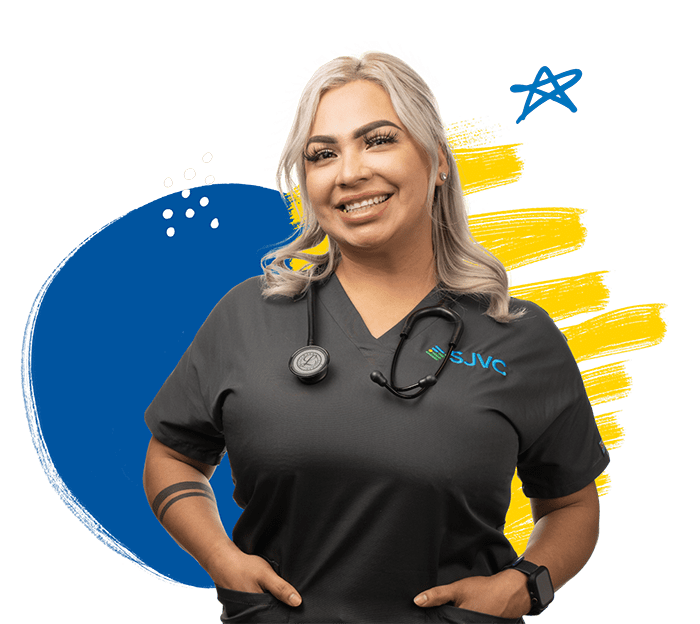Diagnostic Medical Sonography
Enroll at Carrington College, SJVC’s sister school. SJVC is no longer enrolling for this program, our sister school Carrington College is. Students will still have the same faculty, curriculum, and location.

Program Details
WHAT WILL I LEARN?
Ultrasound Techs use special imaging equipment to create images of internal organs. At San Joaquin Valley College, our Diagnostic Medical Sonography students learn:
- Fundamentals and professional aspects of sonography
- Principles and instrumentation of ultrasound
- Abdominal ultrasound imaging
- Obstetrics, gynecology, and vascular imaging
On the job, Sonographers and Ultrasound Technicians can expect to:1
- Prepare patients for procedures by taking a patient’s history and answering any questions about the procedure
- Prepare and maintain imaging equipment
- Operate equipment to get diagnostic images of areas in the patient’s body
- Analyze images to provide preliminary findings for physicians
- Record findings and keep track of patients’ records
Application Process
Military Policy
COST & FINANCIAL AID
Education is the most important investment you can make in your future. There is a financial plan available for everyone, including a broad range of financial assistance options. Visit SJVC’s Net Price Calculator to get personalized information on college costs and financial aid. Check out SJVC’s Academic Catalog to learn about program costs by campus and credential level. You also can talk to an Admissions Advisor to discuss the costs of your chosen program and schedule an appointment with an experienced financial aid officer. Student loans, grants, and scholarships are available to those who qualify.
PROGRAM AVAILABILITY
This program is no longer enrolling at SJVC
Your future comes first—a commitment shared by both SJVC and our sister school Carrington College. While SJVC is no longer enrolling for this program, our sister school Carrington College is. Students will still have the same faculty, curriculum, and location.
Click below to explore this program.
ACCREDITATION & APPROVALS
San Joaquin Valley College is accredited by the WASC Senior College and University Commission (WSCUC), 1080 Marina Village Parkway, Suite 500, Alameda, CA 94501, Phone: 510-748-9001, Fax: 510-748-9797.
The WSCUC is an institutional accrediting body recognized by the Council for Higher Education Accreditation and the U.S. Department of Education.
State Approvals
CALIFORNIA
SJVC is a private institution and is approved to operate as an accredited institution by the California Bureau of Private Postsecondary Education (BPPE). Approval to operate means that SJVC has been found in compliance with the standards set forth in the California Private Postsecondary Education Act of 2009 (as amended) and Title 5, Division 7.5, – Private Postsecondary Education of the California Code of Regulations. As a prospective student, you are encouraged to review this catalog prior to signing an enrollment agreement. You are also encouraged to review the School Performance Fact Sheet, which must be provided to you prior to signing an enrollment agreement.
A student or any member of the public may file a complaint about this institution with the Bureau for Private Postsecondary Education by calling (888) 370-7589 or by completing a complaint form, which can be obtained on the Bureau’s internet website (www.bppe.ca.gov).
CONTINUING EDUCATION FOR GRADUATES
What Will I Learn?
FUNDAMENTALS OF SONOGRAPHY
ULTRASOUND PRINCIPLES & INSTRUMENTATION
ABDOMINAL ULTRASOUND IMAGING
OBSTERTRICS, GYNECOLOGY, & VASCULAR IMAGING
Discover What It’s Like to Become a Diagnostic Medical Sonography Student

Career Opportunities
Diagnostic Medical Sonographers, also known as Ultrasound Technicians, help doctors and other health care professionals assess and identify a patient’s medical conditions. These professionals use imaging equipment that produces high-frequency waves to record images or conduct tests on many parts of the body.
To understand a Diagnostic Medical Sonographer’s daily responsibilities, it is essential you know the difference between an ultrasound and a sonogram. While most use the terms interchangeably when discussing sonography, they are different. Ultrasound refers to the tool used to take a sonogram (or picture). Here is an overview of the daily duties of an ultrasound tech:1
- Explain ultrasound diagnostic imaging to patients and record their medical history
- Follow approved procedures to ensure that diagnostic equipment is working properly
- Operate equipment under authorized diagnostic image practices and approaches
- Review images for clarity, coverage, and suitability to detect the presence or absence of a presumed medical condition
- Distinguish between normal and abnormal anatomy to prepare a summary of your diagnostic findings for the attending physician.
- Record findings and file patients’ records per prescribed procedures
- Sonography professionals may work with doctors and surgeons before, during, and after these day-to-day procedures
Check out our guide on becoming a Diagnostic Medical Sonographer in California
If you love helping people and you are interested in a career in diagnostic imagery or ultrasound technology, sonography may be a great career path for you. Like other advanced care roles, a Diagnostic Medical Sonographer is essential to patient care. While most people think of OB/GYN and babies when they hear the word ultrasound, there’s a wide range of specialties within the field. Learn more about becoming a sonographer, how you can make a difference in patients’ lives, and whether this is the right career choice for you.
Successful Grads
Ask one of our 88,000+ graduates about their SJVC experience and they’ll likely describe it as life-changing.
Want to Learn More?
Request Information
All fields using an asterik (*) are required.
Our RN to BSN program is a Bachelors degree completion option for Registered Nurses.
Diagnostic Medical Sonography FAQ
-
Ultrasound is a diagnostic technique using sound-wave imaging technology to give doctors and medical teams a picture of the soft tissue, organs and bone structure within a human body. This picture enables healthcare providers to determine and diagnose a patient’s problem to come up with treatment options. Ultrasound technology is also often called ultrasonography, sonography or diagnostic medical sonography
-
Vascular imaging is a non-invasive procedure that can produce life-saving opportunities. It uses imaging technology—such as diagnostic ultrasound—to explore circulatory issues, detect blood clots and find blockages. By providing live images of abnormal blood flow, vascular imaging lets medical and healthcare teams diagnose issues and develop treatment options.
-
In the healthcare world, DMS stands for Diagnostic Medical Sonography, also known as ultrasound or ultrasonography. It is a medical imaging technique that uses high-frequency sound waves to generate pictures of structures within a human body, including bones, vascular system and organs. At SJVC, our Associate of Science in Diagnostic Medical Sonography is an ultrasound tech program designed to help you gain the skills you need to pursue career opportunities in the field in as little as 18 months.
-
The key to becoming a diagnostic professional is education. Explore your ultrasound tech educational options. Make sure the college is accredited and offers the program that fits your future. SJVC offers an Associate of Science in Diagnostic Medical Sonography program that covers the ins and outs of sonography in as little as 18 months. From there, you might consider pursuing a professional certification through the American Registry for Diagnostic Medical Sonography (ARDMS). Next, explore your employment options.